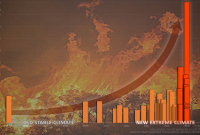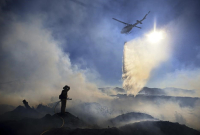SAN FRANCISCO (AP) — Pacific Gas & Electric equipment may have been involved in the start of the big Dixie Fire burning in the Sierra Nevada, the nation's largest utility reported to California regulators.
PG&E said in a report Sunday to the California Public Utilities Commission that a repair man responding to a circuit outage on July 13 spotted blown fuses in a conductor atop a pole, a tree leaning into the conductor and fire at the base of the tree.
The Dixie Fire has grown to 29 square miles (74 square kilometers), largely in remote wilderness. The utility said investigators with the California Department of Forestry and Fire Protection have collected equipment from the location.
PG&E equipment has repeatedly been linked to major wildfires, including a 2018 fire that ravaged the town of Paradise and killed 85 people.
The Dixie Fire is among dozens burning in the parched West.
The destructive Bootleg Fire, one of the largest in modern Oregon history, has already burned more than 476 square miles (1,210 square kilometers), an area about the size of Los Angeles. The blaze just north of the California state line was 25% contained.
Meteorologists predicted critically dangerous fire weather through at least Monday with lightning possible in both California and southern Oregon.
“With the very dry fuels, any thunderstorm has the potential to ignite new fire starts,” the National Weather Service in Sacramento, California, said on Twitter.
Thousands have been ordered to evacuate, including some 2,000 people who live in rugged terrain among lakes and wildlife refuges near the fire, which has burned at least 67 homes and 100 outbuildings while threatening many more.
Climate change has made the West much warmer and drier in the past 30 years and will continue to make weather more extreme and wildfires more frequent and destructive. Firefighters said these conditions in July are more typical of late summer or fall.
Pyrocumulus clouds — literally translated as “fire clouds” — complicated containment efforts Sunday for the Dixie Fire, where flames spread in remote areas with steep terrain crews can't easily reach, officials said. New evacuation orders were issued in rural communities near the Feather River Canyon.
A growing wildfire south of Lake Tahoe jumped a highway, prompting more evacuation orders, the closure of the Pacific Crest Trail and the cancellation of an extreme bike ride through the Sierra Nevada.
The Tamarack Fire, which was sparked by lightning on July 4, had charred about 28.5 square miles (74 square kilometers) of dry brush and timber as of Sunday night. The blaze was threatening Markleeville, a small town close to the California-Nevada state line. It has destroyed at least two structures, authorities said.
A notice posted Saturday on the 103-mile (165-kilometer) Death Ride’s website said several communities in the area had been evacuated and ordered all bike riders to clear the area. The fire left thousands of bikers and spectators stranded in the small town and racing to get out.
Kelli Pennington and her family were camping near the town Friday so her husband could participate in his ninth ride when they were told to leave. They had been watching smoke develop over the course of the day, but were caught off guard by the fire’s quick spread.
“It happened so fast,” Pennington said. “We left our tents, hammock and some foods, but we got most of our things, shoved our two kids in the car and left.”
About 800 fire personnel were assigned to battle the flames by Sunday night, “focusing on preserving life and property with point protection of structures and putting in containment lines where possible,” the U.S. Forest Service said.
A fire in the mountains of northeast Oregon grew to more than 18 square miles (48 square kilometers) by Sunday. The Elbow Creek Fire that started Thursday has prompted evacuations in several small, remote communities around the Grande Ronde River about 30 miles (50 kilometers) southeast of Walla Walla, Washington. It was 10% contained.
Natural features of the area act like a funnel for wind, feeding the flames and making them unpredictable, officials said.
Overall, about 70 active large fires and complexes of multiple blazes have burned nearly 1,659 square miles (4,297 square kilometers) in the U.S., the National Interagency Fire Center said. The U.S. Forest Service said at least 16 major fires were burning in the Pacific Northwest alone.





Comments